Having diabetes is not an issue for driving but if you are taking medications that leave you at risk of hypoglycaemia you must take extra precautions and you must inform the National Driver Licence Service.
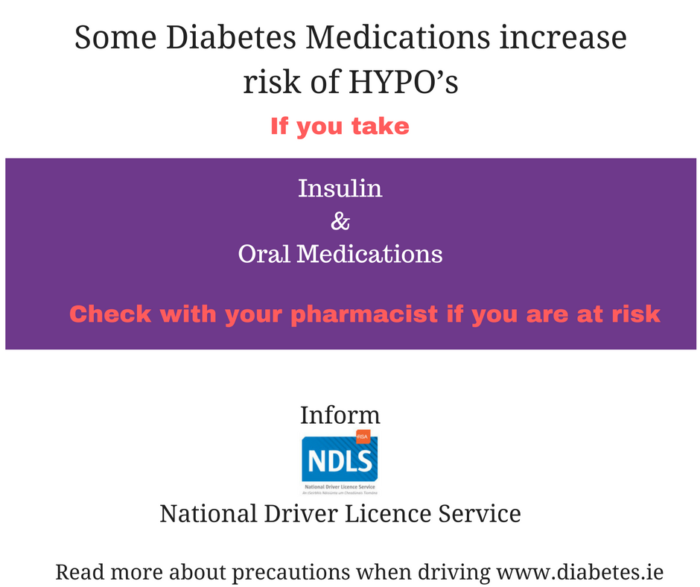
CHECK WITH YOUR PHARMACIST IF YOUR MEDICATIONS LEAVE YOU AT RISK OF HYPOGLYCEAMIA e.g. Insulin or Sulphonylureas such as Gliclazide (Diamicron®) or generic versions such as Diabrezide, Diaglyc, Diacronal MR, Diaclide MR, Gliclazide, Zycron MR.or the post prandial regular Nateglinide (Starlix®).
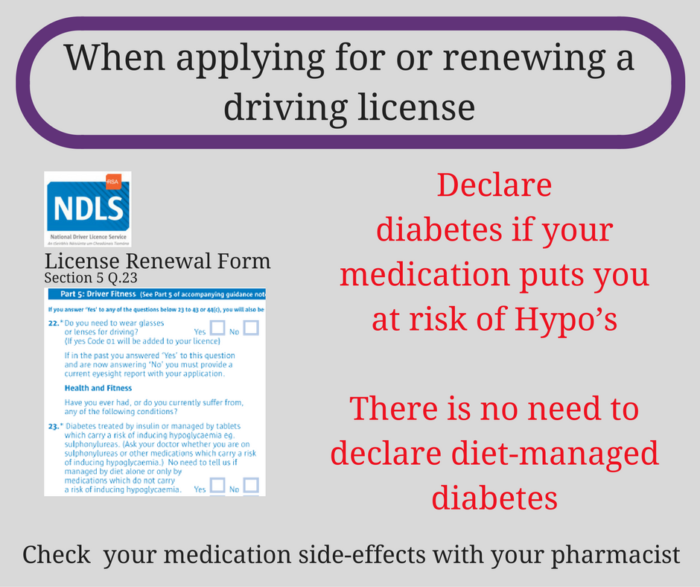
If you are not at risk of hypoglycaemia you do not need to inform the National Driver Licence Service (NDLS). Medicine regimes change therefore remember to tell the NDLS if you start any of the medications that increase the risk of hypoglyceamia.
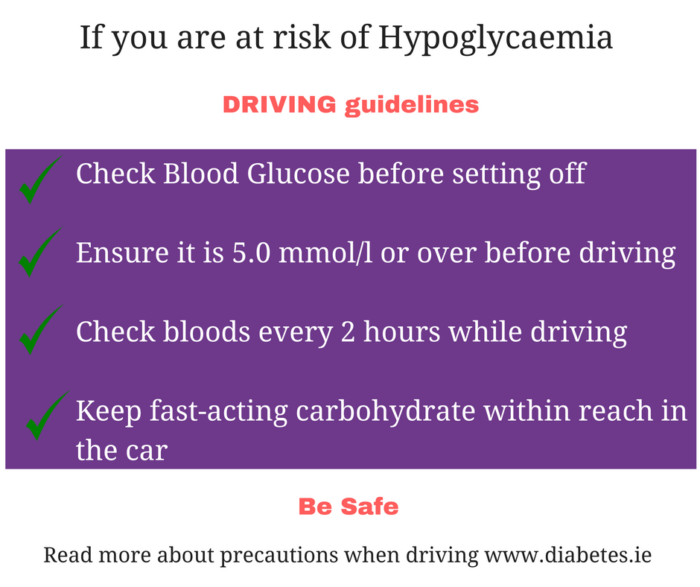
Drivers at risk of hypoglycaemia are advised to take the following precautions:
• You must always carry your glucose meter and blood glucose strips with you. You must check your blood glucose before the first journey and every two hours whilst you are driving.
• In each case if your blood glucose is 5.0mmol/l or less, take a snack. If it is less than 4.0mmol/l or you feel hypoglycaemic, do not drive and take appropriate action to correct glucose level.
• If hypoglycaemia develops while driving, stop the vehicle as soon as possible.
• You must switch off the engine, remove the keys from the ignition and move from the driver’s seat.
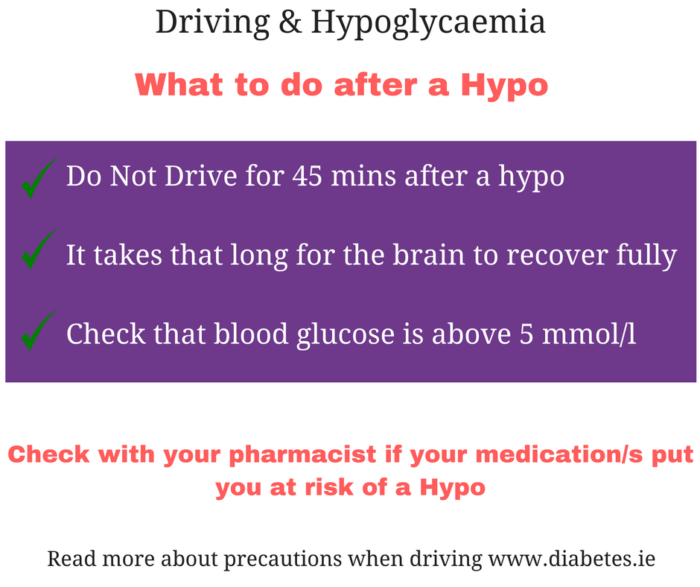
• You must not start driving until 45 minutes after blood glucose has returned to normal. It takes up to 45 minutes for the brain to recover fully.
• Always keep an emergency supply of fast-acting carbohydrate such as glucose tablets, Lucozade or sweets within easy reach in the vehicle.
• You should carry personal identification to show that you have diabetes in case of injury in a road traffic accident.
• Particular care should be taken during changes of insulin regimens, changes of lifestyle, exercise, travel and pregnancy.
• You must take regular meals, snacks and rest periods on long journeys. Always avoid alcohol.
Hypoglycaemia
Hypoglycaemia (also known as a hypo) is the medical term for a low blood glucose (sugar) level. Severe hypoglycaemia means that the assistance of another person is required. The risk of hypoglycaemia is the main danger to safe driving and this risk increases the longer you are on medications that increase your risk of hypoglycaemia (see list above). This may endanger your own life as well as that of other road users. Accidents caused by hypoglycaemia are because drivers carry on driving even though they get warning symptoms of hypoglycaemia occurring. If you get warning symptoms of hypoglycaemia whilst driving, you must always stop as soon as safely possible – do not ignore the warning symptoms.
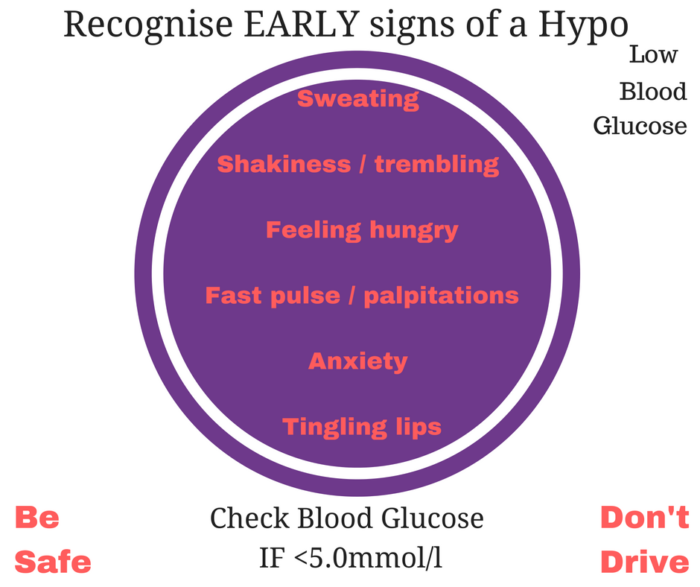
Early Symptoms of Hypoglycaemia include:
• Sweating, shakiness or trembling, feeling hungry, fast pulse or palpitations, anxiety, tingling lips. If you do not treat this it may result in more severe symptoms such as:
• Slurred speech, difficulty concentrating, confusion, disorderly or irrational behaviour, which may be mistaken for drunkenness. If left untreated this may lead to loss of consciousness.
You must also inform National Driver Licence Service when renewing your licence:
• If you have suffered more than one episode of severe hypoglycaemia within the last 12 months. You must also tell us if you or your medical team feel you are at high risk of developing severe hypoglycaemia.
• You have developed an impaired awareness of hypoglycaemia (difficulty in recognising the warning symptoms of low blood sugar).
• You suffer severe hypoglycaemia while driving.
• You don’t meet the vision standards set out in these Guidelines (See Chapter 7 of Sláinte agus Tiomáint Medical Fitness to Drive Guidelines
• You develop any problems with the circulation or sensation in your legs or feet which make it necessary for you to drive certain types of vehicles only, for example automatic vehicles or vehicles with a hand-operated accelerator or brake. This must be shown on your driving licence.
• An existing medical condition gets worse or you develop any other condition that may affect your driving safely.
• If your doctor, specialist or optician tells you to report your condition to the National Driver Licence Service.
For people seeking a HGV licence (Group 2 drivers for bus/lorry) all of the above apply but in addition any episode of severe hypoglycaemia must be reported immediately.
In the interests of road safety, you must be sure that you can safely control a vehicle at all times.
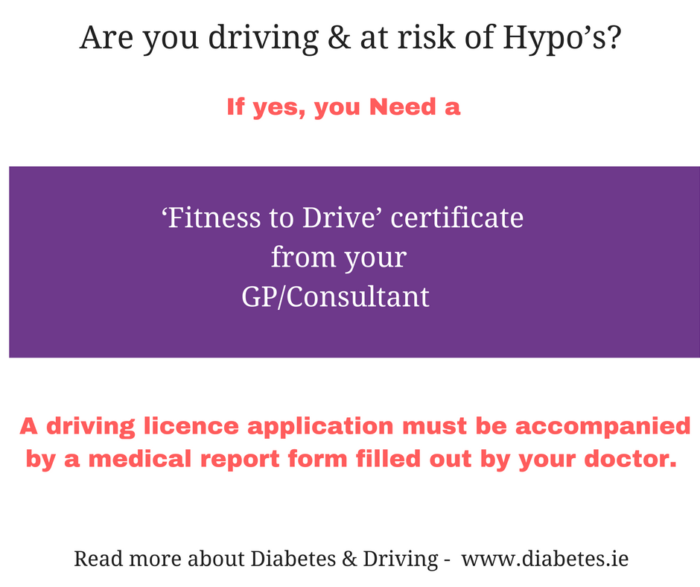
Diabetes & Roadside Drug Testing
Some diabetes medications e.g.. Metformin may cause a positive drug screening result however, the positive result is not an offence as in this case the medication is prescribed and a positive test is not an offence unless accompanied by impaired ability to drive. Download Medicines and Driving for more information or talk to your prescribing doctor
Tip
Carry some identification of the medication you are taking e.g. take a photo of the prescription or a letter from the pharmacist stating what your medicines are prescribed for.
Renewing your licence for a Class 1 licence – Cars and Motor Cycles
Each time a person with diabetes at risk of hypoglycaemia wishes to renew their driving licence, they must present a completed medical form (completed within the previous month) stating their fitness to drive. The duration of the medical certification of fitness to drive will determine the duration of licence you can apply for. If you are on medication that can potentially cause hypos, and you meet the medical standards as outlined in the medical fitness to drive guidelines a 1-3 year licence will be issued. Diabetes Ireland acknowledges that the shorter duration imposes additional costs and is seeking the implementation of alternative practices.
Renewing your licence for a Class 2 licence – Trucks, Buses and Trailer Vehicles
Only an issue if you are at risk of hypoglycaemia, which requires you to present a completed medical form (completed within the previous month) stating your fitness to drive. The duration of the license is one year and is dependent on having appropriate understanding and awareness of hypoglyceamia, no episodes of “severe” hypoglyceamia, and you must demonstrate regular monitoring (at least twice daily and regularly at times relevant to driving) using a meter with memory capacity. For your medical review, you must have three month’s blood glucose readings. Qualifying Conditions which also must be met include:
• No episode of hypoglycaemia requiring the assistance of another person has occurred in the preceding 12 months.
• Must have appropriate awareness of hypoglycaemia at appropriate glucose level.
• Must demonstrate an understanding of the risks of hypoglycaemia.
• Will not be able to apply until your condition has been stable for a period of at least one month.
• Must regularly monitor your condition by checking blood glucose levels at least twice daily and at times relevant to driving. A glucose meter with a memory function to measure and record blood glucose levels must be used.
• At the annual examination by a consultant endocrinologist, 3 months of blood glucose readings must be available.
• Must have no other condition which would render you a danger when driving Group 2 vehicles.
• You will be required to comply with the directions of doctors(s) treating your diabetes and to report immediately to the NDLS any significant change in your condition.
Medical Report
Guidelines from the Road Safety Authority (RSA) and the Royal College of Physicians of Ireland (RCPI) state that a driving licence application must be accompanied by a medical report form filled out by your doctor. See the following link for more information
Link: https://www.ndls.ie/medical-fitness/do-i-need-to-submit-a-medical-report.html
Eyesight
See Chapter 7 of medical fitness to drive standards for visual disorders
Link: https://www.ndls.ie/images/PDF_Documents/NDLS_Sla%CC%81inte_&_Tioma%CC%81int_2022_v8.pdf
Limb Problems
Limb problems/amputations are unlikely to prevent driving. They may be overcome by driving certain types of vehicles e.g. automatics or one with hand controls.
Please note: The above is taken from Driving Guidelines for people with Diabetes – source: Medical guidelines “Sláinte agus Tiomáint; Medical Fitness to Drive Guidelines”.
Read full report: https://www.ndls.ie/images/PDF_Documents/NDLS_Sla%CC%81inte_&_Tioma%CC%81int_2022_v8.pdf

